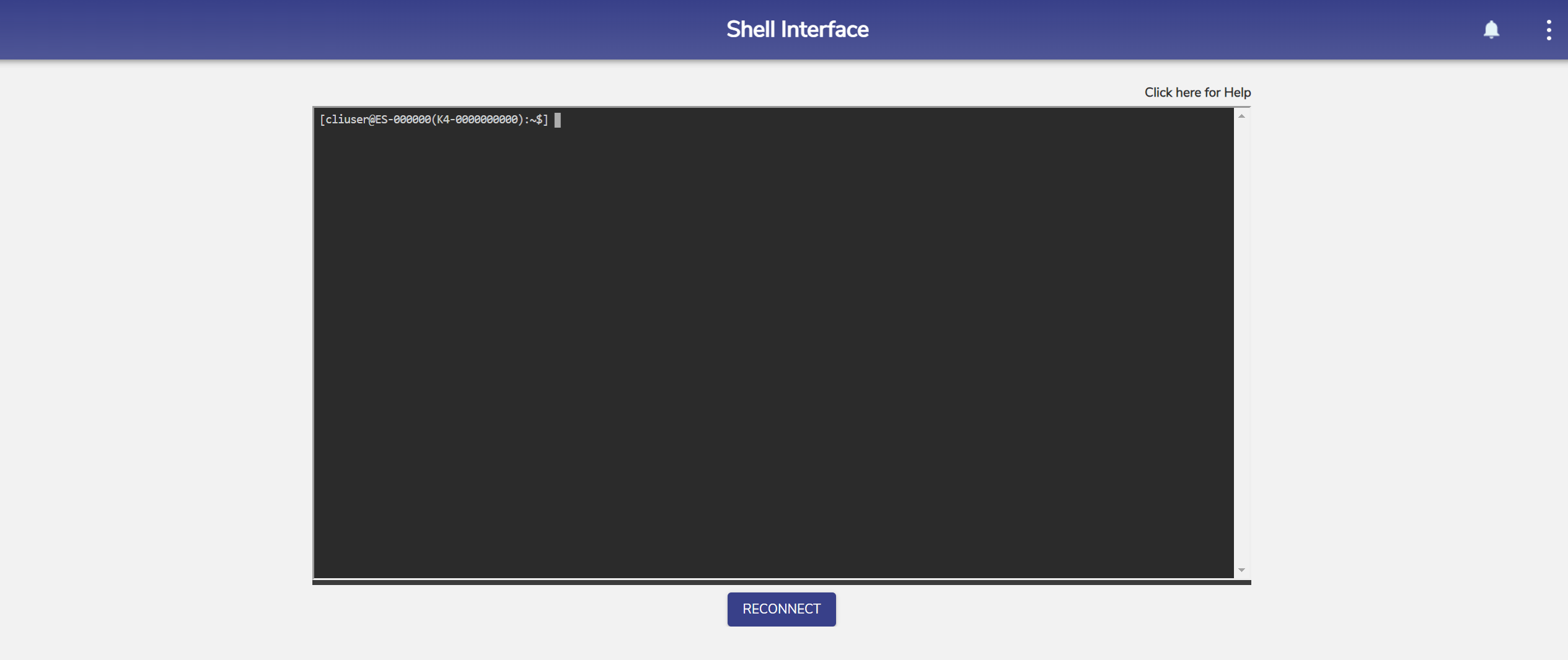Shell Interface
Keywords: cli, command line, shell interface
The EdgeOS Shell Interface is a convenient way to run low-level commands for troubleshooting and diagnostics.

The full list of commands are available here: https://cdn.k4mobility.com/cdn/edge/doc/k4help.pdf
Command List
The following commands and arguments are supported in the Shell Interface:
tunepre
k4.debug.tunepre helpk4.debug.tunepre dumpk4.debug.tunepre <parameter> <value>This command can be used to tune the PRE parameters.
<parameter>can be one of:rtt_timeout,rtt_window,rate_window,rate_threshold,sample_interval,reweight_time,mini_bounded_rate, ormini_bounded_rate_vtp.Run the 'help' sub-command to see details of the parameters.
The 'dump' subcommand will show the current values of these parameters.
iftop
k4.monitor.iftop [-i interface] [-t target] [-- iftop-options]This command can be used to run the Linux 'iftop' command.
'iftop' listens to network traffic on a named interface or on the first interface it can find which looks like an external interface if none is specified, and displays a table of current bandwidth usage by pairs of hosts.
When used with the '-i' option, it will show the named native WAN interface.
When used with the '-t' option, it will show traffic for the named native target host.
The 'iftop-options' are the same as in the usual Linux 'iftop' command.
Run 'man iftop' for details of the Linux 'iftop' command.
ping
k4.monitor.ping [-i interface] [-- ping-options] targetk4.monitor.ping [-v interface] [-- ping-options] targetk4.monitor.ping [-l vlan] [-- ping-options] targetk4.monitor.ping [-- ping-options] targetThis command can be used to 'ping' a target IP or FQDN.
'ping' uses the ICMP protocol's mandatory ECHO_REQUEST datagram to elicit an ICMP ECHO_RESPONSE from a host or gateway.
When used with the '-i', '-v', or '-l' options, specifies the interface or VLAN through which the ping is conducted.
The 'ping-options' are the same as in the usual Linux 'ping' command.
Run 'man ping' for details of the Linux 'ping' command.
speedtest
k4.monitor.speedtest [-s server] [-i interface] [-- speedtest-options]k4.monitor.speedtest [-s server] [-v interface] [-- speedtest-options]k4.monitor.speedtest [-s server] [-l vlan] [-- speedtest-options]This command will run a speed test using the Linux 'speedtest' utility.
'speedtest' measures latency, jitter, packet loss, download bandwidth, and upload bandwidth.
The '-s', '-i', '-v', and '-l' options specify the server, interface, or VLAN for the test.
The 'speedtest-options' are the same as in the usual Linux 'speedtest' command.
Run 'man speedtest' for details of the Linux 'speedtest' command.
traceroute
k4.monitor.traceroute parametersThis command will run the Linux 'traceroute' utility.
'traceroute' tracks the route packets take to reach a host.
The parameters are the same as those taken by the Linux 'traceroute' command.
Run 'man traceroute' for details.
tshark
k4.monitor.tshark parametersThis command will run the Linux 'tshark' utility.
'tshark' is a network protocol analyzer.
The parameters are the same as those taken by the Linux 'tshark' command.
Run 'man tshark' for details.
iptraf
k4.monitor.iptraf [parameters]This command will run the Linux 'iptraf-ng' utility.
'iptraf-ng' generates various network statistics.
The parameters are the same as those taken by the Linux 'iptraf-ng' command.
Run 'man iptraf-ng' for details.
wget
k4.monitor.wget parametersThis command will run the Linux 'wget' utility.
'wget' is for non-interactive download of files from the Web.
The parameters are the same as those taken by the Linux 'wget' command.
Run 'man wget' for details.
reboot
k4.op.rebootThis command will reboot the system, after asking for confirmation.
ssh
k4.op.ssh parametersThis command will run the Linux 'ssh' utility.
'ssh' is for secure encrypted communications between two untrusted hosts over an insecure network.
The parameters are the same as those taken by the Linux 'ssh' command.
Run 'man ssh' for details.
mlvpn
k4.ops.mlvpn [ip country]This command will set the VOE server address to the specified IP & country.
When called with no parameters, it shows the current VOE server address and the status of the configured VTP tunnels.
show
k4.show.arpThis command will show the ARP cache.
It runs the 'ip -n neigh show' Linux command.
k4.show.dhcp [vlan<vid> | <subnet>]This command will show the current leases assigned by the Kea DHCP server.
If a VLAN or subnet is specified, only the leases pertaining to those will be displayed.
k4.show.firewallThis command will list the current firewall rules.
k4.show.interfacesThis command will list all non-virtual interfaces, their status, addresses assigned, and any TC configurations.
It also shows the speed and duplexity of Ethernet interfaces.
k4.show.multicast interfaceThis command will show the count of received multicast packets on the specified interface.
If no interface is specified, it will show the count for each VLAN interface.
del.dhcp
k4.del.dhcp ipThis command will delete the existing lease for the specified IP from the Kea DHCP server.
